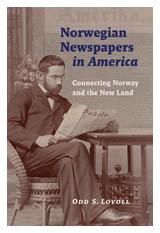Norwegian Newspapers in America: Connecting Norway and the New Land by Odd S. Lovoll | MHS Press | 432 pages, $24.95
If you happened to pick up Odd S. Lovoll’s sixth book, Norwegian Newspapers in America, you might wonder, “Why Norwegians? Why, indeed, newspapers in America?” For Lovoll, though, the project has been gestating since the late 1960s, when he pored over “the newspapers’ yellowing pages printed in Gothic script and an archaic Dano-Norwegian linguistic form” in the service of his master’s thesis on the North Dakotan Norwegian press. Since then, the immigrant press in America—particularly the Norwegian press—has “held a special scholarly fascination” for Lovoll, a historian who holds the King Olav V Chair in Scandinavian-American Studies at St. Olaf College in Minnesota. The result is an ambitious labor of love.
 Which is not to say that the Norwegian-American press holds a scholarly or even an idle fascination for the lay reader—at least, perhaps not 350 pages worth, plus appendices. But Lovoll’s own enthusiasm for his subject saturates every page of his story, whose main characters are the (estimated) 280 Norwegian American secular periodicals extant in the U.S. between 1847 and 2010. The first appeared some twenty years after the first fifty-two Norwegian immigrants to the United States arrived in New York in October 1825—after that, new ones popped up regularly as the Norwegians expanded early settlements in the upper Midwest and also spread into the west, Texas, and New York.
Which is not to say that the Norwegian-American press holds a scholarly or even an idle fascination for the lay reader—at least, perhaps not 350 pages worth, plus appendices. But Lovoll’s own enthusiasm for his subject saturates every page of his story, whose main characters are the (estimated) 280 Norwegian American secular periodicals extant in the U.S. between 1847 and 2010. The first appeared some twenty years after the first fifty-two Norwegian immigrants to the United States arrived in New York in October 1825—after that, new ones popped up regularly as the Norwegians expanded early settlements in the upper Midwest and also spread into the west, Texas, and New York.
There is much here that is particular to the Norwegian American press, of course, and much that is universal to the American press. Newspapers flower and fade. Editors snipe at rival publications with bloglike venom—one suggests that a rival publication’s death was due to “inflammation of the brain [Hjernebetændelse] with periodic attacks of insanity.” The papers have start-up pains and sustainability pains; they embrace, disavow, or wrestle with partisanship; they have uneasy relationships to authority even while they wield their own. Norwegian newspapers, in sum, are subject to the heartache and the thousand natural shocks the press is heir to, and in that sense their triumphs and failures are instructive.
But the goal for the editors and publishers at America’s immigrant newspapers wasn’t just to sustain a paper, but to sustain a people. Again, the story is a familiar one to which Lovoll brings the perspective of the particularist. Lovoll somewhat repetitively intones that the newspapers built local, American communities while maintaining links to the homeland, and that their role implied no contradiction between assimilation and ethnic pride. But he is admirably thorough in documenting how the papers achieved this.
One of the earliest of them, Wisconsin’s Nordlyset, curated reports from Norway’s newspapers—albeit at intervals dictated by the pace of sea travel, trans-Atlantic telegraph lines lying some years in the future. At the same time, Lovoll writes, “editors favored an American emphasis in their selection of materials for their readers.” The paper provided Norwegian translations of selections of the Declaration of Independence, and devoted an entire issue to reprinting the 1848 Wisconsin constitution in full. Meanwhile, letters to the editor knit together a Norwegian American social network.
In general, the Norwegian American press thrived through three waves of emigration to the U.S. from Norway, the last in 1910. Throughout, it butted heads with the other major Norwegian American institution in the U.S.—the Norwegian Synod, which staked its own claim to be the organizing social force among Norwegians in the new country. Notably, the Norwegian press in America was an early voice for abolition; the Synod was just as loud an advocate for slavery.
Otherwise, the Norwegian press found itself on “all sides of issues” in the American political landscape as it chronicled the Civil War, two World Wars, Prohibition, and the Depression, alongside the day-to-day foibles of its community. But with passing generations and no continued, large-scale migration, the Norwegian-language press in the United States shrank and then almost entirely disappeared. Such can be the perils of niche publishing. An editor muses near the end of the book: “The Norwegian American Press produced… an enormous number of words, which when you come right down to it, were written in the sand.”
Still, at the very least, as Lovoll concludes, “newspapers from the past are absorbing reading material; contemporary reporting about a time that was and now long gone provides modern-day readers insights on life in unknown forebears.” Through his own study, Lovoll shows what it was like for a community to be adjust to America, and adds a colorful yarn to the tapestry of the American immigrant experience.
Click here for a complete Page Views archive.
Kathy Gilsinan is the associate editor at World Politics Review
